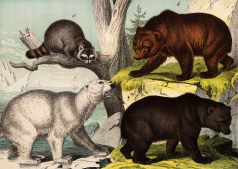Exploring the Presence of Lions in Art and Architecture of Ancient Societies
Lions have long been revered as symbols of strength, courage, and majesty in various cultures throughout history. Their depiction in art and architecture reflects the significant role they played in ancient societies, often embodying both divine power and royal authority. This article explores how lions were represented across different civilizations and what these representations reveal about the cultures that created them.
The Symbolism of Lions in Ancient Egypt
In ancient Egypt, lions were associated with fierce protection and royalty. The goddess Sekhmet, depicted as a lioness, embodied war and healing. Statues of lions often adorned temples and tombs, symbolizing protection for the deceased on their journey to the afterlife. The Sphinx at Giza is one of the most iconic examples of lion symbolism, merging human intellect with animal strength to represent pharaohs’ power over both the natural world and their subjects.

Lions in Mesopotamian Art
Mesopotamia also featured lions prominently in their art. The famous Ishtar Gate from Babylon showcases beautifully glazed brick reliefs depicting lions as symbols of Ishtar’s power—she was a goddess associated with love, war, and fertility. Additionally, Assyrian kings would often hunt lions as a demonstration of their bravery; bas-reliefs depicting these hunts served not only as art but also as propaganda to showcase royal prowess.
Greek Interpretations: Lions in Sculpture
In ancient Greece, lions were frequently used in sculpture to convey heroism and nobility. The Nemean Lion from mythological tales becomes a symbol for Hercules’ strength when he defeats it during his first labor. Statues like those found on temple pediments or public squares often showcased lion imagery to evoke protection or serve as guardians at entrances—a practice seen later during Roman times where lion statues adorned many public buildings.
The Role of Lions in Chinese Culture
In ancient China, lions held profound significance although native lions had never existed there; they were inspired by Indian Buddhist culture where they symbolized authority and protection against evil spirits. Stone lion statues known as ‘shishi’ or guardian lions typically flanked entrances to important buildings such as temples or imperial palaces—believed to ward off malevolent forces while inviting prosperity through their auspicious presence.
Lions Among Native Cultures: Mesoamerican Representations
While not native animals themselves, representations akin to lions can be found within Mesoamerican cultures such as the jaguar which was revered similarly for its strength and prowess. Artistic depictions include intricate carvings on temples showing jaguar-like creatures serving symbolic purposes aligned with royalty or deities—highlighting humanity’s longstanding admiration for powerful feline figures throughout diverse cultural landscapes across time periods.
Throughout history, from Egyptian monuments through Greek sculptures to Asian guardian figures—all forms echo humanity’s fascination with majestic felines like lions that symbolize mightiness beyond mere physicality; they embody societal values intertwined deeply within cultural narratives that continue influencing artistic expression even today.
This text was generated using a large language model, and select text has been reviewed and moderated for purposes such as readability.


